
In my cemetery travels in the past 12 years, one of the popular spots for cemetery
enthusiasts to visit is in Hollywood Cemetery in Richmond, Virginia. A life size cast iron life
dog sits on top of a toddlers grave who was buried there in 1862. The sad story
and dog statue are well known. Visitors come from all over to see the grave and leave mementos and trinkets for the young life taken way to soon.
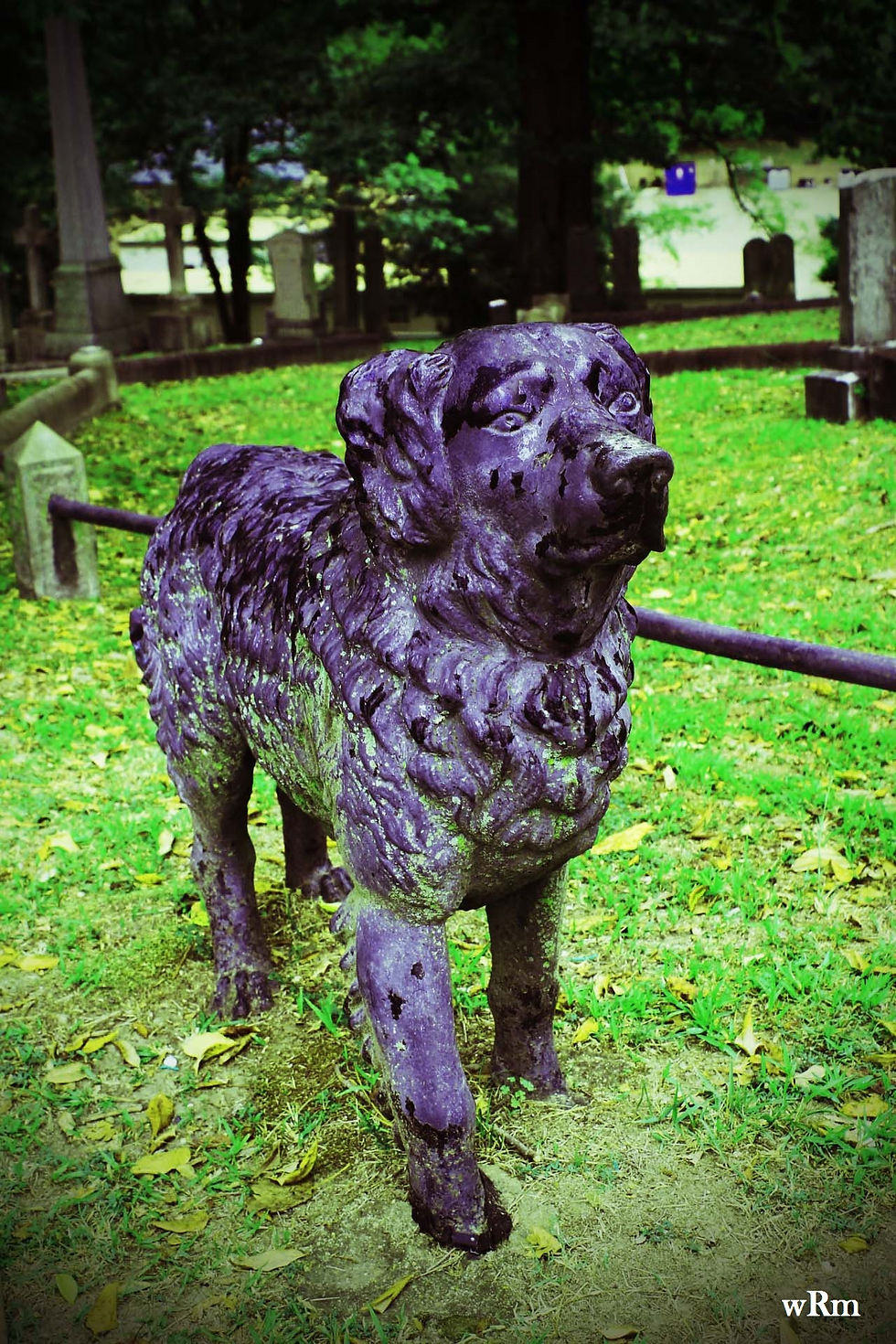
I recently got the chance to see the cemetery and statue in person. When I came home to look through the pictures a thought occurred to me about another dog statue in Illinois that I had photographed about ten years before in the Hinsdale Pet Cemetery in Willowbrook, Illinois. I pulled a picture I had taken of the dog in the pet cemetery and sure enough looking at the two photographs side by side they were identical. This started me thinking if the two could be related
somehow.
First, I emailed Hinsdale and asked what they knew about the statue. They only knew the personal story of when and why it was placed where it was.
So I continued on researching both statues I had photographed and this is what I found:
The Iron dog that sits in Hollywood Cemetery sits on the family plot of Charles R. Rees. In a news article dated May 16, 1949 Charles granddaughter, Ada R. Bailey, writes an editorial letter telling the story that her father, James Rees Sr., told about his families iron dog many times. Those buried in the Rees family plot are James Sr.'s siblings, parents and cousins.
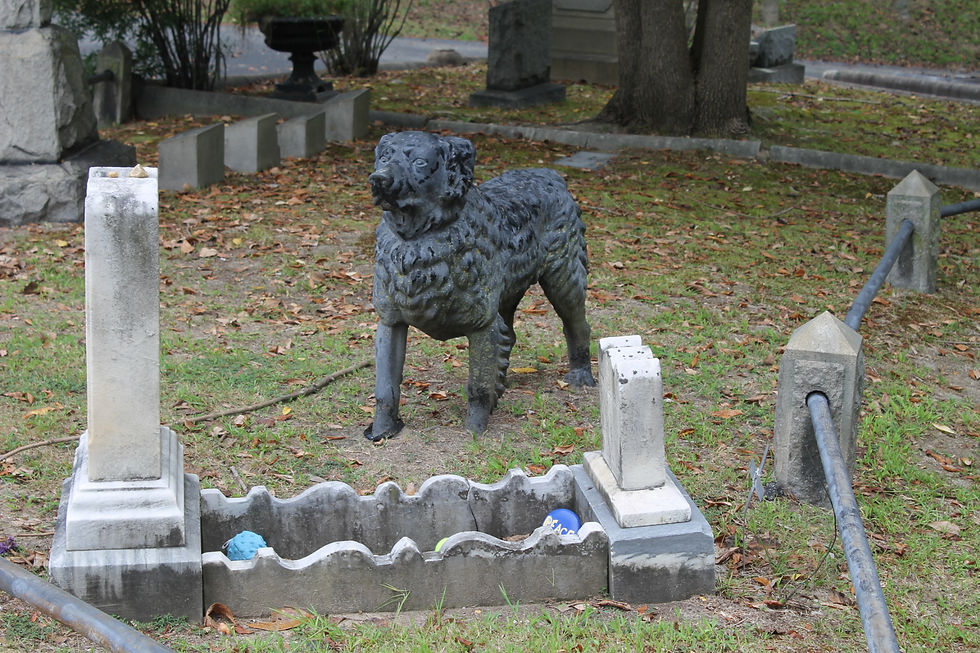
Charles moved to Richmond in 1857 and owned a Photography Gallery there during the
civil war. He and his young family lived close by the shop and Charles would often walk with his very young children through town. The dog statue originally sat in front of a store. Charles bought the dog for his son Charlie after seeing how much the young child loved it. Every time he would see the dog he would climb on top of it and "ride". The iron dog became a beloved family treasure. Charles moved the statue when it became endangered of being confiscated to be melted down for war bullets just prior to the Civil war ending in 1865. Other stories about the iron dog in Hollywood have circulated. So many that there is even a book written about this particular statue, its history, legends and lore. The account from a family member who was a first hand witness is really the best documentation you can get as with Rees's granddaughter Ada.

The dog is placed next to toddler Florence Bernardin Rees's marble cradle style headstone as if guarding the little one. The lot was purchased by her father Thomas and uncle Charles. She died at just shy of three years old on February 7, 1862 of scarlet fever and was the second child buried in the lot. The first was Jennie Agnes “Pinky” Rees who died at six months three days on July 20, 1859. ( Richmond Dispatch 25 Jul 1859)
Several weeks after Florence died, her six year old cousin Eddie died of the scarlet fever on March 30, 1862. In April of 1863, Charles and his wife welcomed baby girl Minnie. She lived until age two when she died in August of 1865. Birdie Rees was next born in August of 1868 she lived to a month shy of six years old when she died in July of 1874. Little "Charlie" or Charles Ricard Rees Jr. that rode the iron dog was born in January 1870. He is one of two of the six Rees children to survive childhood. Charlie made it to 35 and died in 1905. James moved to Petersburg in 1888 and lived with his daughter until 1955 at age 95. He is buried in Petersburg.
The other dog I identified as identical to the Hollywood Cemetery dog, sits in one
of the oldest pet cemeteries in the US, Hinsdale Pet Cemetery in Willowbrook Illinois.
According to the cemetery the statue was placed there by John P. Stankowicz,
a previous owner, sometime before the cemetery was established in 1926.
In 1921 John and his family, living in Russia, were raided by the Bolsheviks. Arap's barking alerted the family in time for them to escape.Because of Arap, Johns family survived. Unfortunately Arap did not. Soon after John made it to the US. He wanted to memorialize the brave dog who had saved his life. So he placed the life sized cast iron dog upon a concrete block that bore the dogs name on the front and a sweet epitaph on the side that reads
"He gave up his life that a human might live, greater love hath no man."
When I told Hinsdale in an email that I knew of an identical statue they were surprised as they had never heard about another like it.
Where I located personal stories about both statues, I saw nothing about the statues
themselves. No information on where they came from or where they were made etc.
I had read that the statues were modeled after the Newfoundland breed. So I started by
looking for more of these statues. I finally located an old article from the 1960's by
the Newfoundland Quarterly. I learned that these dogs were indeed old and very
special!!
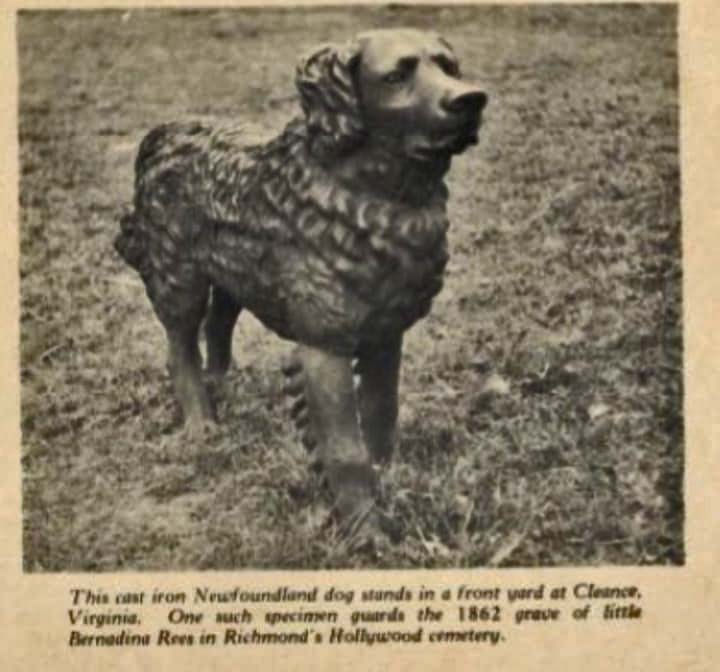
The iron dogs were originally made by one of the worlds largest iron works Hayward,
Bartlett & CO. in Baltimore, MD. For many years a pair of the iron dogs sat on either
side of the entrance to the iron company in Baltimore as their mascots. They even
have names. One is Sailor and the other is Canton. The iron statues were named after
two Newfoundland puppies that eventually came to Baltimore from Newfoundland on a
ship named Canton in 1807. A gentlemen named George Law was aboard that ship. In a letter dated January 1845, George told the story of how the pups, intended for someone else, came with him to Baltimore. During the Canton's voyage from Newfoundland to Baltimore, they came across an English ship on its way to Norfolk from Newfoundland. The English ship had come through a severe storm and was close to sinking. George rode on one of the small rescue boats sent to recover those remaining on the sinking ship. The ship was devastated having lost many crew members, passengers and all of its rescue boats. George found on board a set of pups, one male, one female. They had been commissioned by a man in Baltimore who was in the Newfoundland trade. He owned the English ship and asked the captain to find him a pair of Newfoundland pups of the best breeding but of different families. George bought them from the captain for one guinea a piece. Upon his final return to Baltimore the pups were given to friends of his. The female who he said was black went to West River, MD and the male, a dingy red color went to Sparrows point, MD. Both dogs became accomplished water dogs with excellent skills for duck hunting.There is no evidence that the pair were breed together but were breed with other mates that evolved over the years to eventually produced the Chesapeake Bay retriever line which was recognized in 1877.
In 1832 George Hayward immigrated to Baltimore and began working in the iron stove
industry. In 1844 David Bartlett opened an iron store in Baltimore. The two partnered
with Georges brother Jonas in 1849 and formed Hayward, Bartlett and Company.
They started out making stoves, architectural iron works, plumbing items, built
locomotives and heating apparatus.
Both George and Jonas were avid sportsman and for many years owned three ducking clubs in the area. Iron animal statuary became very popular in the 1850's. The men with their interests in hunting and dogs chose to immortalize the Sailor and Canton story by producing the life size iron dogs and naming them after the young pups brought to Baltimore many years before.

The first statue made was placed outside of the office of Hayward, Bartlett & CO. on Light street in Baltimore. It was later moved to join its mate at their ironworks plant on Scott and Pratt streets. In 1899 the dogs were put in a scrap pile when new offices were built. After the statues were removed, the company went into a decline. The statues were recovered from the scrap and returned to the plant. The company did better after their return. The Koppers Company of Pittsburgh PA bought Hayward, Bartlett and Co. in 1927 but the company remained where it was as a division of the larger one.
An employee of the company states that when the Hayward Bartlett location of Koppers was demolished the statues were moved to the Koppers Piston Ring and Seal plant on Hamburg Street in West Baltimore until they closed in the 80's.
In 1987 a pair was donated to the Maryland Center for History and Culture in Baltimore, Maryland by the Koppers company. These are the original set that adorned the Hayward, Bartlett Company entrance in Baltimore.
In October 2021. A Hayward, Bartlett Co. iron dog statue was donated to the Baltimore Museum of Industry by Dorothea Lankford. The statue sat in front of her family home in Brooklandville, MD for many years and became a beloved family heirloom as well. When Dorothea sold her home she decided the statue should be in the museum where it would be preserved to carry on the story. They call him Sailor and he now sits outside of the Baltimore Museum of Industry overlooking the Baltimore Harbor. They also have on display the wooden mold the iron dogs were made with. It is believed there were two molds made identical except for very minor differences due to the fact that they were hand carved.
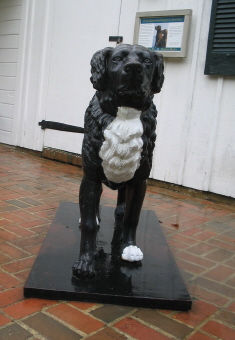
Two other locations in Maryland have iron dogs from the Baltimore Company.
A single statue sits outside The Chesapeake Bay Maritime Museum in St. Michael’s, MD. It was donated some time around 1987 as well.
A pair sits in front of BGE’s Spring Gardens location in Baltimore, MD.
No where on any list is the one located at the Hinsdale Pet Cemetery. I believe it is one of the originals cast in Baltimore as well.
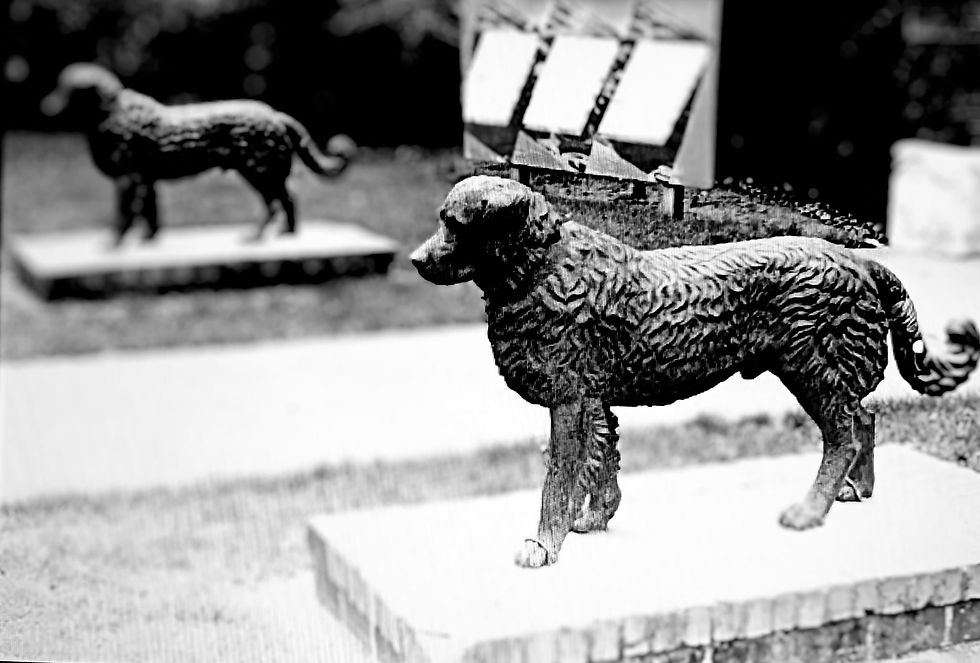
In addition to the Hinsdale find I also located, in my research for this blog, a set in Santa Rosa, California at the Junior college there. The college websites states that this pair came from Hayward, Bartlett and Co in Baltimore. It was purchased by a family in San Francisco sometime around 1900. They were damaged in a earthquake in 1906 and sent to Santa Rosa to William James Yandle for repair. The family never reclaimed the set of statues so Yandle put them at his private home. When World War two started there was a metal shortage. The government asked citizens to conduct metal drives to collect and melt metal for war efforts. Many old iron fences and old iron statuary were lost during this time. The Yandle family had become attached to their dogs as the others had and did not want to see them melted down. Mrs. Yandle loaned them to the Santa Rosa Junior college in 1943 and that is where they remain today.
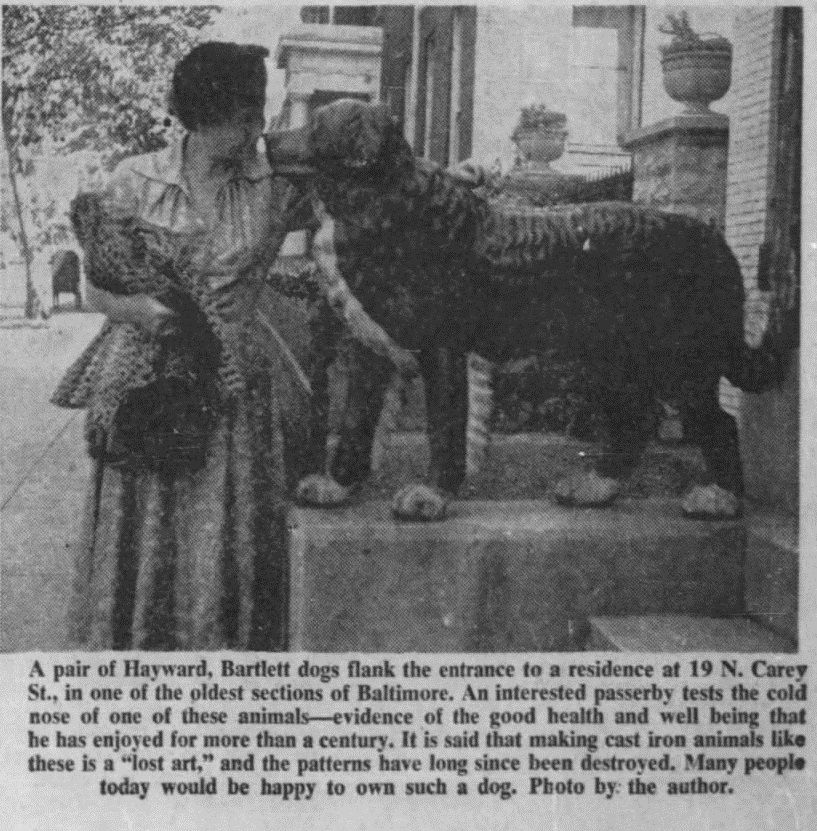
A Pair also sits at the Westfield Memorial Hospital in Westfield, NY.
In 1978 Barbara Berry’s article in the May/June ACC Bulletin tells this history of the statues there:
“‘The late Hubert Thompson, then Editor of the Westfield Republican, organized the fund needed to purchase back the dogs from a Mr. Oley Benson of 471 Delaware Aye, Buffalo who had in turn purchased them from a Mr. Callahan. The dogs had originally been given as a contribution to the scrap drive during the World War II effort.
“The Spencer home, which became the Westfield Hospital, was built by Dr. John Spencer, a noted agriculturist, in 1853. It is thought the dogs, of a hollow cast iron, were apart of the original embellishments of the Spencer estate as the home and the dogs, positioned now in front of the building, are pictured in an 1881 atlas.
“The hospital opened as a 17 bed facility on August 29,1942. In the article of 1955 when the dogs were returned to Westfield, it states, ‘They will be painted black and relocated on the lawn of the Westfield Memorial Hospital. If the time comes when they are no longer wanted there they will be placed on the Westfield Academy and Central School lawn.’
“About every person who grew up in Westfield can relate a tale told them about the iron dogs. “They bark every time the fire whistle blows” was a favorite story told the youngsters. Since they were inanimate objects and never did hear the fire whistle blow, this was not an untruth.
“Many a youngster has sat astride the mastiffs and as can be observed, the iron statuary was fashioned to give the dogs a friendly facial expression.”
The dogs still remain at the hospital. Photos of this pair can be seen here: https://westfieldhospitalfoundation.org/history/
There were other old news articles with known locations given at the time the articles were written. One said to be In Eagle , PA in front of an antiques store.
I then found the below the photo of an iron dog in Central Park in San Mateo, California. The article states it was made in Italy but it does suspiciously look like the ones from Baltimore except for the neck. This one looks as though something is around his neck!

This made me wonder if anyone else had produced these dogs.
Robert Wood established his foundry in Philadelphia, PA in 1840. They produced a newfoundland statue very similar the the Baltimore dogs. Apparently the body is elongated on the Philadelphia statues.
I only found two photos of and very little info on iron dog statues that are said to be a Robert Woods. The article and one photo you can see here: https://www.bi-gardenantiques.com/newsletter/lyndhurst/

The author of the article never says where the pictured statue is located. The only thing she says about the dogs in particular is this:
"Robert Wood produced some of the finest and most coveted animal statuary ever made, including the “long-bodied” version of the Newfoundland dog that was made first, in smaller proportions, by Hayward, Bartlett & Co. of Baltimore."
The advertisement pictured right features an image of the dog statue and was printed around 1858 .
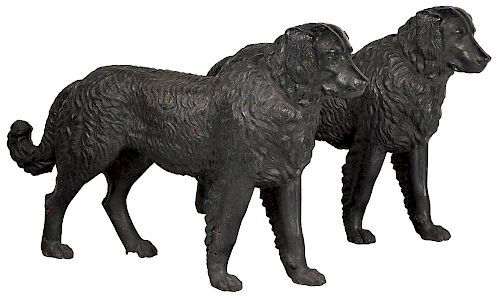
The second photo I found was of a set on auction/antique website Pook & Pook. The site states that the pair were sold for $46,000 in April of 2017. They also say that this is the only existing pair. You can see the webpage here:
In a strange coincidence a few days ago local Richmond News channel 8 WRIC ran this story. I've been in touch with creator Ryan Nadeau. He was kind enough to share his contacts from the story with me. Thank You Ryan!! We also both marveled at the fact that we got drawn into the story at the same time with absolutely no connection.His story starting with the dog statue in Hollywood cemetery, mine with the one I found in Illinois. You can read his article here : https://www.wric.com/history/florence-iron-dog-hollywood-cemetery/
I also reached out to the Baltimore Industrial Museum. Their Archives Research Coordinator Ken Jones was super helpful in clarifying some things and answering questions! Thank you!!
If there is any misinformation you see here please contact me with details!! I like to give the most accurate account of what I am writing about so if its wrong let me know and I will correct it!!
Thanks for reading!!
Wendy
Links to a few articles I used :
Article
Baltimore Museum of Industry
Westfield Memorial Hospital



Comments